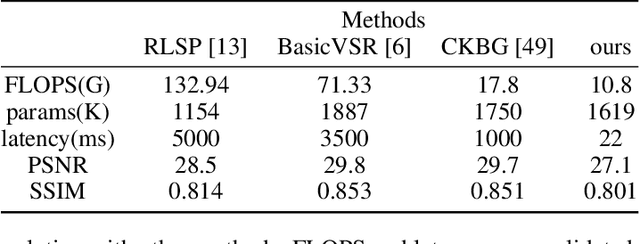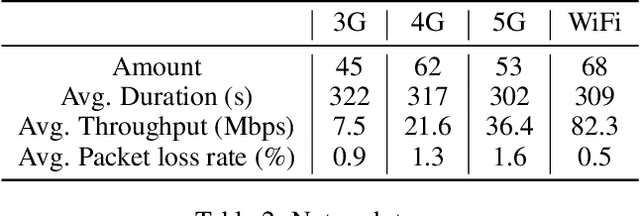Zhaoyuan He
Real-Time Neural Video Recovery and Enhancement on Mobile Devices
Jul 22, 2023



Abstract:As mobile devices become increasingly popular for video streaming, it's crucial to optimize the streaming experience for these devices. Although deep learning-based video enhancement techniques are gaining attention, most of them cannot support real-time enhancement on mobile devices. Additionally, many of these techniques are focused solely on super-resolution and cannot handle partial or complete loss or corruption of video frames, which is common on the Internet and wireless networks. To overcome these challenges, we present a novel approach in this paper. Our approach consists of (i) a novel video frame recovery scheme, (ii) a new super-resolution algorithm, and (iii) a receiver enhancement-aware video bit rate adaptation algorithm. We have implemented our approach on an iPhone 12, and it can support 30 frames per second (FPS). We have evaluated our approach in various networks such as WiFi, 3G, 4G, and 5G networks. Our evaluation shows that our approach enables real-time enhancement and results in a significant increase in video QoE (Quality of Experience) of 24\% - 82\% in our video streaming system.
Neural Video Recovery for Cloud Gaming
Jul 22, 2023Abstract:Cloud gaming is a multi-billion dollar industry. A client in cloud gaming sends its movement to the game server on the Internet, which renders and transmits the resulting video back. In order to provide a good gaming experience, a latency below 80 ms is required. This means that video rendering, encoding, transmission, decoding, and display have to finish within that time frame, which is especially challenging to achieve due to server overload, network congestion, and losses. In this paper, we propose a new method for recovering lost or corrupted video frames in cloud gaming. Unlike traditional video frame recovery, our approach uses game states to significantly enhance recovery accuracy and utilizes partially decoded frames to recover lost portions. We develop a holistic system that consists of (i) efficiently extracting game states, (ii) modifying H.264 video decoder to generate a mask to indicate which portions of video frames need recovery, and (iii) designing a novel neural network to recover either complete or partial video frames. Our approach is extensively evaluated using iPhone 12 and laptop implementations, and we demonstrate the utility of game states in the game video recovery and the effectiveness of our overall design.
Adaptive Scheduling for Edge-Assisted DNN Serving
May 02, 2023Abstract:Deep neural networks (DNNs) have been widely used in various video analytic tasks. These tasks demand real-time responses. Due to the limited processing power on mobile devices, a common way to support such real-time analytics is to offload the processing to an edge server. This paper examines how to speed up the edge server DNN processing for multiple clients. In particular, we observe batching multiple DNN requests significantly speeds up the processing time. Based on this observation, we first design a novel scheduling algorithm to exploit the batching benefits of all requests that run the same DNN. This is compelling since there are only a handful of DNNs and many requests tend to use the same DNN. Our algorithms are general and can support different objectives, such as minimizing the completion time or maximizing the on-time ratio. We then extend our algorithm to handle requests that use different DNNs with or without shared layers. Finally, we develop a collaborative approach to further improve performance by adaptively processing some of the requests or portions of the requests locally at the clients. This is especially useful when the network and/or server is congested. Our implementation shows the effectiveness of our approach under different request distributions (e.g., Poisson, Pareto, and Constant inter-arrivals).
 Add to Chrome
Add to Chrome Add to Firefox
Add to Firefox Add to Edge
Add to Edge